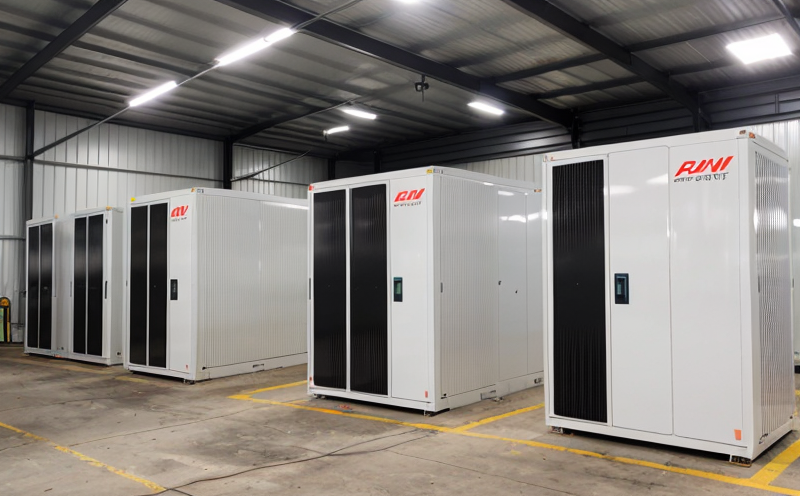IEC 60068 Environmental Testing of Batteries and Systems
The International Electrotechnical Commission (IEC) standard IEC 60068 provides a comprehensive suite of tests to ensure the durability and reliability of batteries and energy storage systems in extreme environmental conditions. This standard is crucial for manufacturers, quality managers, compliance officers, and R&D engineers who aim to ensure that their products meet stringent performance criteria across diverse environments.
The primary focus of IEC 60068 testing is on the robustness of batteries and energy storage systems under various environmental stresses such as temperature, humidity, altitude, mechanical shocks, and vibrations. This ensures that these devices perform reliably in real-world conditions without compromising safety or functionality.
During the testing process, batteries and systems undergo a series of environmental challenges to simulate the harsh conditions they might encounter during their lifecycle. These tests are critical for validating product design choices and ensuring compliance with relevant regulations. By adhering to IEC 60068 standards, manufacturers can enhance the safety and performance of their products, thereby gaining a competitive edge in the market.
The testing protocol is designed to be rigorous yet realistic, allowing engineers to identify potential weaknesses early in the development process. This proactive approach not only improves product quality but also reduces costs associated with post-market failures. Compliance with IEC 60068 can significantly enhance brand reputation and customer trust, which are vital factors for any business operating in the energy sector.
For those involved in R&D or procurement, understanding these testing parameters is essential. The standards provide a clear roadmap for what needs to be tested, how it should be done, and the criteria that must be met. This ensures that all stakeholders have a common reference point when discussing product specifications and compliance requirements.
To summarize, IEC 60068 environmental testing of batteries and systems is about ensuring that these critical components can withstand the harshest conditions they might encounter in their operational environment. The tests are not just a formality but a crucial step in maintaining high standards of quality and reliability.
Scope and Methodology
| Test Parameter | Description | Methodology |
|---|---|---|
| Temperature Cycling | Simulates thermal cycling in a wide range of temperatures. | The device is subjected to rapid temperature changes, typically between -40°C and +85°C, for specified durations. |
| Vibration Testing | Assesses the impact of mechanical vibrations on battery performance. | The specimen is placed in a controlled environment where it experiences oscillations that mimic real-world transportation conditions. |
| Humidity Cycling | Evaluates how humidity affects battery integrity and functionality. | The device undergoes cycles of high humidity to simulate storage or operational environments with high moisture levels. |
| Pressure Testing | Determines the effectiveness of seals and enclosures under pressure changes. | Specimens are exposed to varying pressures, including vacuum conditions, to assess their structural integrity. |
The methodology outlined in IEC 60068 is designed to be adaptable. It allows for modifications based on the specific requirements of the product being tested or its intended use. This adaptability ensures that the tests remain relevant and effective, providing a robust framework for environmental stress testing.
Testing typically involves placing the battery or system in controlled environments where it is subjected to predefined conditions. The duration and severity of each test are determined by the expected usage scenarios and regulatory requirements. Compliance with these standards not only ensures product reliability but also supports broader efforts towards sustainable energy solutions.
Why Choose This Test
- Ensures compliance with international standards, enhancing market access.
- Identifies potential weaknesses early in the product development cycle.
- Improves overall product reliability and safety.
- Reduces costs associated with post-market failures.
- Enhances brand reputation and customer trust.
- Aids in meeting regulatory requirements, thereby avoiding penalties and delays.
The IEC 60068 test is a critical step in the development process that ensures products can withstand the rigors of real-world usage. By choosing this test, manufacturers demonstrate their commitment to quality and safety, which are essential for building trust with consumers and regulatory bodies alike.
Environmental and Sustainability Contributions
- Reduces Waste: By ensuring products can withstand extreme conditions, manufacturers reduce the likelihood of premature failures. This minimizes waste generated from discarded products that do not meet performance expectations.
- Promotes Recycling: Products that pass IEC 60068 tests are more likely to be recycled due to their durability and reliability. This supports broader recycling efforts within the industry.
- Energy Efficiency: Reliable batteries contribute to more efficient energy storage systems, which in turn reduce overall energy consumption and carbon footprints.
The IEC 60068 test is not just about ensuring product reliability but also plays a crucial role in promoting sustainability. By choosing this test, manufacturers can contribute positively to environmental stewardship while maintaining high standards of quality and compliance.





